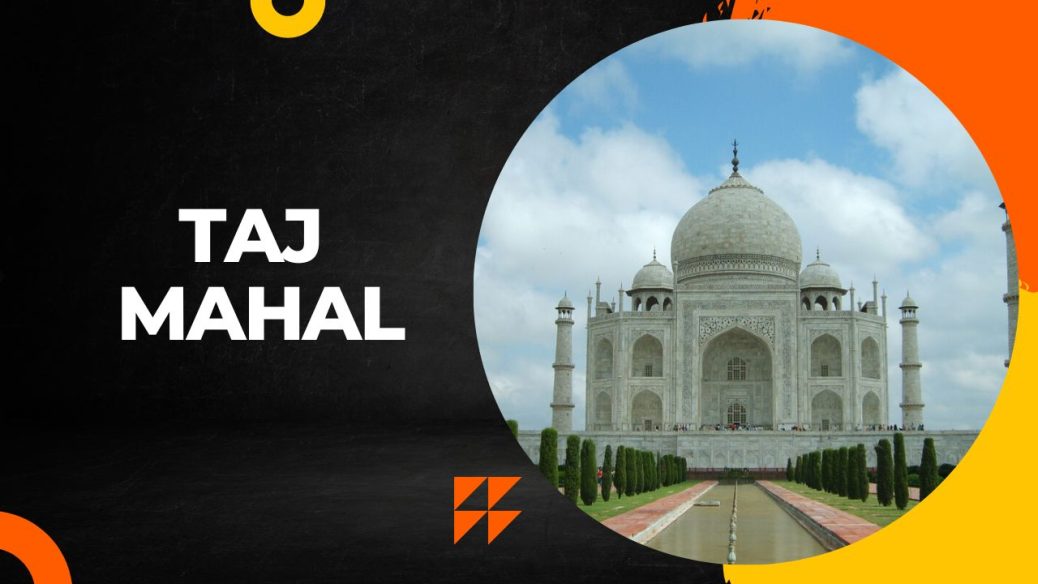“Taj Mahal: A Monument of Love and Beauty.”
Table of Contents
Analyzing the Significance of the Taj Mahal in Indian Culture
Appreciating the Symbolism Behind the Iconic Taj Mahal
Investigating the Different Components that Make Up the Taj Mahal
Examining the Complex Geometric Designs of the Taj Mahal
Exploring the Intricate Artwork Found in the Taj Mahal
Unveiling the History Behind the Building of the Taj Mahal
Introduction
The Taj Mahal is one of the world’s most iconic and beautiful monuments to love. Located in the Indian city of Agra, this white marble mausoleum was commissioned by Mughal Emperor Shah Jahan in 1632 in memory of his beloved wife, Mumtaz Mahal. It is widely considered one of the most remarkable examples of Mughal architecture, a style that combines elements of Persian, Islamic, and Indian designs. Not only is the Taj Mahal a symbol of everlasting love, but it is also a testament to the skill and creativity of the workers and craftsmen who constructed it.
Analyzing the Significance of the Taj Mahal in Indian Culture
The Taj Mahal is one of the most renowned monuments in the world and holds immense cultural and historical significance to the people of India. Built in the 17th century by Mughal Emperor Shah Jahan, the Taj Mahal stands as a symbol of love and devotion to his beloved wife, Mumtaz Mahal. It is a testament to the grandeur of Indian architecture and has been described as a teardrop on the face of eternity.
The Taj Mahal is a UNESCO World Heritage Site and is widely considered to be the jewel of Muslim art in India. It is a symbol of love, beauty, and power and has been celebrated in poetry, literature, and art for centuries. Its grandeur and immense cultural significance have been honored by various world leaders and dignitaries. The Taj Mahal has become an iconic symbol of India and is often seen as a representation of the country’s rich cultural heritage.
The Taj Mahal has been the subject of many works of art, music, and literature throughout the centuries. It is often referenced in popular culture and its beauty and grandeur have been immortalized in films and television. In addition, the Taj Mahal is a major tourist attraction and millions of people visit the monument every year to admire its beauty and grandeur.
The Taj Mahal is an important symbol for the people of India and holds a deep cultural significance. It is a reminder of the country’s rich history, culture
Appreciating the Symbolism Behind the Iconic Taj Mahal
The Taj Mahal is an iconic symbol of love and beauty, making it one of the most recognizable monuments in the world. Built in the 17th century as a mausoleum for Mughal emperor Shah Jahan’s beloved wife, Mumtaz Mahal, it has come to represent the peak of Mughal architecture. The Taj Mahal’s exquisite design and intricate details have made it a symbol of love, beauty, and eternal devotion.
The Taj Mahal is a masterpiece of symmetry and balance. Its white marble walls are adorned with intricate carvings and inlaid marble works of art, with a central dome surrounded by four smaller domes. The entire building is laid out in a symmetrical pattern, with a large gate at the entrance and four gates at the four cardinal directions. This layout has symbolic meaning, representing the four pillars of the Islamic faith: faith, prayer, pilgrimage, and charity.
The Taj Mahal’s beauty is further enhanced by the surrounding gardens and fountains, which create a tranquil atmosphere and provide a peaceful backdrop for reflection and contemplation. The gardens also have a symbolic meaning as they represent the paradise of paradise on earth. They are filled with flowers, trees, and shrubs, symbolizing love, joy, and fertility.
The Taj Mahal is a symbol of love and devotion, a testament to the enduring power of love. It is a reminder that love is the
Investigating the Different Components that Make Up the Taj Mahal
The Taj Mahal is a vast mausoleum complex located on the banks of the Yamuna River in Agra, India. Built in the early 17th century, the Taj Mahal is one of the most iconic structures in the world and a symbol of India’s immense history. The complex is comprised of multiple architectural elements that have been constructed with incredible skill and attention to detail. Here, we will investigate the various components that make up this impressive monument.
The main structure of the Taj Mahal is the mausoleum, which houses the tombs of the Mughal emperor Shah Jahan and his beloved wife Mumtaz Mahal. The mausoleum is built of white marble and is topped with a bulbous dome that is almost 35 meters in height. The dome is surrounded by four smaller domes, each of which is surrounded by four chattris, or kiosks. The four minarets that flank the building are a unique feature of the Taj Mahal and are made with red sandstone.
The entrance to the mausoleum is marked by the Great Gateway, a large red sandstone arch that is decorated with intricate carvings and calligraphy. The gateway is flanked by two smaller gateways and is guarded by two small pavilions, known as the Naubat Khana. The complex also includes a number of other pavilions, which were used to host special occasions

Examining the Complex Geometric Designs of the Taj Mahal
The Taj Mahal is one of the world’s most iconic and beloved architectural masterpieces. It stands as a testament to the grandeur of the Mughal Empire, and its intricate and complex geometry is a testament to its creators’ immense talent and skill. The Taj Mahal is composed of a number of geometric shapes and patterns, all of which come together to form a unified and harmonious whole.
At the center of the Taj Mahal is the central dome, which stands as the focal point of the building. This dome is constructed from a combination of ribbed and flat arches and is surrounded by four minarets that rise up to the sky. The dome is also decorated with intricate patterns and designs, including a series of radiating petals along its base. These petals create a sunburst effect and are complemented by smaller concentric circles above.
The Taj Mahal is also adorned with a number of other geometric designs, including a series of vertical and horizontal lines which run along the walls of the building. These lines are believed to have been designed to represent the Islamic concept of the ‘unity of God’. The horizontal lines also represent the four elements of earth, air, fire, and water, and the vertical lines represent the five pillars of Islam.
In addition to the geometric patterns of the Taj Mahal, the building is also decorated with a number of intricate carvings and sculptures. These include a number of floral and
Exploring the Intricate Artwork Found in the Taj Mahal
The Taj Mahal is one of the most iconic monuments in the world, renowned for its intricate artwork and stunning architecture. Located in Agra, India, it is a mausoleum built by Mughal Emperor Shah Jahan in memory of his beloved wife Mumtaz Mahal. The Taj Mahal is a symbol of love and devotion, and its beauty and grandeur have captivated visitors from all over the world.
The intricate artwork found in the Taj Mahal is one of its most remarkable features. The artwork can be found throughout the entire monument, from its walls and arches to the tombs and gardens. The artwork is a combination of Islamic, Persian, and Indian artistic styles, and is a testament to the skill of the artisans who designed and constructed it.
The exterior walls of the Taj Mahal are covered in intricate carvings and calligraphy. These carvings depict scenes from the Mughal Empire, as well as verses from the Quran. The main entrance of the Taj Mahal is made up of two large arches that are decorated with intricate floral and geometric patterns. The interior walls are also decorated with carvings and calligraphy, as well as marble inlays.
The tombs of Mumtaz Mahal and Emperor Shah Jahan are located in the center of the Taj Mahal. They are intricately decorated with semi-precious stones, marble inlays, and
Unveiling the History Behind the Building of the Taj Mahal
The Taj Mahal is one of the Seven Wonders of the World and is an iconic symbol of India’s rich cultural history. Built between 1631 and 1648 by the Mughal Emperor Shah Jahan, the Taj Mahal was constructed in memory of his favorite wife, Mumtaz Mahal. The building of the Taj Mahal was a labor of love, but it was also a reflection of the wealth and power of the Mughal Empire.
Shah Jahan inherited the Mughal Empire in 1628 and expanded it to its greatest extent. This wealth allowed him to build the Taj Mahal, a lavish mausoleum that was constructed to honor his beloved wife. The emperor commissioned the best architects, sculptors, and artisans from across the empire to work on the project.
The construction of the Taj Mahal took more than 20 years and is estimated to have cost around 32 million rupees. Thousands of workers, including masons, stonecutters, painters, and calligraphers, were employed to build the mausoleum. The workers were provided with food and clothing, and a labor force of some 20,000 men from India, Persia, the Ottoman Empire, and Europe was used to construct the building.
The Taj Mahal is made of white marble, which was sourced from quarries in Makrana, Rajasthan, and other parts of northern India. The marble was brought to Ag
Conclusion
The Taj Mahal is a symbol of love, devotion, and beauty that has captivated people for centuries. Its grandeur and majesty have made it one of the most iconic structures in the world, and its importance in Indian culture cannot be understated. Its incredible architecture and history make it a must-see destination for anyone looking to experience the culture and history of India. The Taj Mahal is a symbol of love that will continue to captivate people for generations to come.






